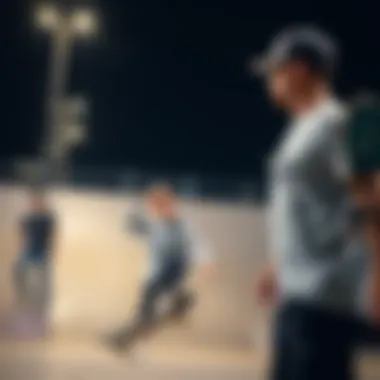Diverse Career Paths in the Skateboarding Industry


Intro
The world of skateboarding has transformed significantly over the years. What began as a niche pastime has morphed into a vibrant industry teeming with career opportunities. Whether you’re a rider yourself, a parent of a budding skater, or a retailer looking to enter this exciting field, understanding the diverse paths available can make all the difference.
One cannot ignore the ever-evolving nature of skateboarding. From professional competitions to behind-the-scenes roles in marketing and coaching, the current landscape is as dynamic as it gets. The objective here is to shed light on the myriad pathways skaters and enthusiasts can travel, explore the skills needed for success, and provide practical insights into the skateboarding ecosystem.
Let’s kick things off with an examination of skateboarding techniques, a foundational aspect for anyone aiming to make a name in this arena.
Skateboarding Techniques
Skateboarding is as much about style and finesse as it is about technical skill. No aspiring skateboarder can thrive without an understanding of the basics, followed by a mastery of more advanced tricks.
Mastering the Basics
In the beginning, it’s crucial to get comfortable on the board. Here, learning basic maneuvers such as pushing off, turning, and stopping sets a strong foundation. Notably, understanding your skateboard's components—like the deck, trucks, and wheels—can improve control and performance significantly.
Some basics include:
- Pushing: The first step to gaining momentum.
- Balancing: Finding your center of gravity is key while riding.
- Stopping methods: Techniques like foot braking can save you from rough landings.
Once you've got the hang of these fundamental skills, it opens the door to trying out some tricks.
Advanced Tricks and Stunts
Once comfortable with the board, the real fun begins. The more advanced techniques and tricks provide opportunities for creative expression and participation in competitions. Tricks like ollies, kickflips, and 360s take a lot of practice but can set you apart from the crowd.
For those who aspire to reach a professional level, honing the following skills is often essential:
- Board control: Being in tune with the board and executing tricks smoothly.
- Agility: Quick reflexes can make or break a successful trick execution.
- Creativity: Developing a personal style will attract attention in competitions or video parts.
"Creating a signature trick or style can elevate a skater's profile, often leading to sponsorships and career opportunities."
By mastering both basic and advanced techniques, you not only improve your own skating but also lay a strong foundation for potential career options, whether as a professional skater or a coach. Let's delve into the next vital aspect—gear and equipment.
Gear and Equipment
Equipping oneself with the right skateboard and safety gear can mean the difference between enjoying the sport and facing unnecessary injuries. Understanding the kinds of skateboards available and crucial protective equipment is an essential next step for any serious skater.
Skateboard Types and Features
There are various types of skateboards designed for different styles of riding. Some popular skateboard types include:
- Street skateboards: Typically smaller, designed for tricks and grinding.
- Cruisers: Larger with softer wheels, ideal for casual riding and commuting.
- Longboards: Known for stability and speed; great for downhill racing.
Each type comes with specific features catering to different styles and preferences. Choosing the right skateboard can enhance performance and comfort, ultimately boosting confidence on the board.
Essential Safety Gear
No discussion about skateboarding would be complete without addressing safety gear. It’s vital to strike a balance between style and safety. The essentials typically include:
- Helmets: Protects the head during falls.
- Knee and elbow pads: Cushions against impacts and scrapes.
- Wrist guards: Prevent injuries while taking hard falls.
When gearing up, it’s important to select products that meet safety standards and fit comfortably. Not only does this promote safety, but it also encourages longer skate sessions without discomfort.
For those seeking further knowledge or community engagement, resources such as Wikipedia, Britannica, and forums on Reddit can provide invaluable information.
Understanding the Skateboarding Landscape
Skateboarding is much more than a means of transportation. It represents culture, creativity, and a lifestyle that has evolved significantly over the decades. Understanding the skateboarding landscape is key to grasping the possibilities within it, especially for those contemplating a career tied to this dynamic subculture.
The skateboarding world is continuously changing due to various factors, from advances in technology to the influence of social media. These elements not only shape how skateboarding is practiced but also how it is marketed and perceived by both enthusiasts and outsiders. For instance, the rise of platforms like Instagram and TikTok has allowed skaters to share their skills with a global audience, creating new avenues for careers that didn't exist before.
The Evolution of Skateboarding
Skateboarding traces its origins back to the 1950s in California, where surfers sought to skate on land when the waves were flat. Initially, boards were simply wooden planks with roller skate wheels attached. As the sport gained traction, it evolved into a sophisticated activity, embracing tricks, competitions, and various styles.
By the 1970s, skateboarding was well on its way to becoming a culture in its own right, thanks to the introduction of skate parks and the innovation of new tricks. The 1980s ushered in the era of the legendary professional skateboarders like Tony Hawk and Rodney Mullen, who shaped skateboarding’s future through competition and creativity. Fast forward to today, skateboarding is not just a sport but a multifaceted industry, encompassing everything from board manufacturing to media production. As a result, numerous career options have sprung forth, catering to diverse interests ranging from performance to marketing and beyond.
"Understanding the evolution of skateboarding can help you see where it's heading, making it easier to carve your own niche in this thrilling profession."
Current Trends in Skate Culture
In modern times, the essence of skate culture encapsulates a sense of community and individual expression. Current trends indicate a strong movement towards inclusivity, with skaters from various backgrounds coming together to push the boundaries of the sport. Gender representation has become more prominent, with female skaters making significant strides, challenging stereotypes and gaining visibility in competitions and media.


Social media remains a powerful tool in shaping skate culture, fostering connections and enabling sponsorship deals for emerging skaters. The idea of "content creation" is prevalent, with skaters building their personal brands through videos, vlogs, and tutorials. Collaborations are common between brands and skaters, which has created a lucrative side for many, transforming enthusiasts into entrepreneurs.
In addition, sustainability is increasingly becoming a focal point within the skate community. Eco-conscious brands are gaining recognition, emphasizing the importance of environmentally friendly materials and production methods. This shift not only appeals to the ethical values of contemporary skaters but also prepares them for the future of the industry that demands awareness of ecological impacts.
To sum it up, the skateboarding landscape is vibrant and evolving quickly. By understanding its history and how current trends shape the industry, aspiring skaters, coaches, and marketers can find their place in this exciting realm.
Career Paths in Skateboarding
Exploring career opportunities in skateboarding offers a glimpse into the intersection of passion, sport, and business. The skateboarding community isn’t limited to just those who ride; various roles exist, from coaching to content creation, that play essential parts in this vibrant culture. Understanding these paths not only reveals a wealth of potential jobs but also highlights the diversity found within skateboarding. For many enthusiasts, turning a passion into their profession comes with unique benefits, like community support and creativity. Before diving into specifics, let's unravel what makes each pathway distinct and crucial in the skateboard world.
Professional Skateboarder
Path to Professionalism
The journey to becoming a professional skateboarder often starts on the streets or local parks, where countless hours are spent honing skills. This informal routing is essential, allowing skaters to develop their style and technique organically. The key characteristic of this path is dedication. It’s not merely about tricks; it’s a lifestyle commitment that requires consistency and resilience.
A professional skateboarder's life can be exhilarating yet filled with challenges. One unique feature of this career is its unpredictability—where success isn't just about skill but also about visibility and marketability. This path can lead to various rewards, such as sponsorships, event invitations, and a chance to influence the next generation. However, it’s not all smooth sailing; injuries and financial instability may crop up. Still, for many, the thrill of skating professionally outweighs the drawbacks.
Competitive Events and Sponsorships
Competitive events are the heartbeat of professional skateboarding, providing a stage for skaters to showcase their abilities. These competitions can range from local meets to global championships. A noteworthy aspect is sponsorships, which play a pivotal role in elevating a skater's career. When brands recognize talent and potential, they often step in to offer financial backing or equipment. This symbiotic relationship can be greatly beneficial, offering financial security and resources for the skater while enhancing the brand's image in the market.
Unique to this aspect are the varied paths sponsorship opportunities can open. While they can greatly enhance a professional skater's platform, they also impose certain expectations and duties to maintain the relationship with the brands. It's a double-edged sword where commitment can lead to long-term partnerships, but failure can mean losing support quickly.
Skateboarding Coach
Certification and Training
Turning one's experience into coaching requires both skill and formal training. Certification courses for skateboarding coaches can vary widely in content and structure, yet they all aim to establish a baseline for what it takes to teach effectively. The key characteristic of this career choice is its educational merit. It’s not just teaching tricks; it’s about fostering a safe and comprehensive learning environment.
The unique feature of obtaining certification is that it adds credibility. Coaches equipped with recognized training can attract more students. This allows them to connect with aspiring skateboarders effectively. However, prospective coaches face the disadvantage of navigating the competitive landscape, where certifications alone may not guarantee a position.
Teaching Methodologies
Skateboarding coaching also demands robust teaching methodologies tailored to different skill levels. These strategies might involve breaking movements into manageable steps or incorporating various drills tailored to individual learning speeds. The essential characteristic here is adaptability—what works for one student may not resonate with another.
A captivating aspect of effective teaching is the ability to engender confidence in learners. Coaches who can inspire their students build a reliable reputation. However, balancing the need for structured lessons while allowing for creativity can be challenging. Finding that sweet spot is crucial to success in this role.
Skateboarding Photographer and Videographer
Developing a Portfolio
In the visual, expressive world of skateboarding, capturing moments through photography or videography is an exciting niche. Developing a compelling portfolio is crucial for photographers wishing to cement their presence in skate culture. The key characteristic of this profession is creativity; it requires an eye for unique angles and moments that perfectly depict the energy of skating.
A well-curated portfolio serves as a powerful tool to attract clients and collaborators. It often becomes a skater's visual resume, showcasing your artistic take on the sport. The unique feature of a strong portfolio is that it can represent different styles—from action shots to candid moments. However, building this may involve the challenge of initial investment in equipment and time before any payback is seen, which requires patience and commitment.
Working with Brands and Magazines
The intersection of skateboarding photography and brands is an avenue for creativity to transform into profit. Working with brands and magazines can provide both exposure and income. This relationship is vital in promoting skate culture through visual storytelling. The essential characteristic is the establishment of trust and connection—brands need artists who can represent their values authentically.
The unique feature of this collaboration is the potential for long-term contracts or one-off projects that can bolster a photographer's reputation. Yet, it’s not always easy; competition is fierce, and rejections can be common. Photographers must persevere, staying true to their vision while adapting as the industry evolves.
Skateboarding Content Creator
Platforms and Audience Engagement
In this digital age, content creation has exploded as a career opportunity within skateboarding. Platforms like Instagram, YouTube, and TikTok offer a chance to engage with audiences and share skating experiences. The key characteristic here is engagement—it's not enough just to create; connecting with followers is what builds a loyal community.
Unique to this role is the immediacy of feedback from the audience. Content creators receive instantaneous reactions, which can be both rewarding and challenging. Tailoring content to maintain interest requires diligence in monitoring trends and viewer preferences. There are advantages in creating a personal brand that resonates with fans, but it also puts pressure on creators to consistently produce content that wows.
Monetization Strategies
As content creators build their platforms, the need for monetization strategies becomes paramount. These can range from affiliate links, sponsored content, or merchandise sales. The important aspect of monetization is its diversity; there are numerous ways to make a living while sharing knowledge of skateboarding.
Unique to this strategy is the ability to navigate multiple streams of income. Creators can diversify through various platforms or collaborations, lessening the reliance on a single income source. However, achieving sustainable income often demands considerable effort in terms of content creation and audience management, posing challenges for newcomers in the field.
In summary, the skateboarding industry opens a world of diverse and dynamic career paths. Each role, whether as a professional skater, coach, photographer, or content creator, carries its own unique opportunities and challenges, fostering an engaging community that thrives on passion, creativity, and innovation.
Supporting Roles Within the Industry
In the skateboarding world, supporting roles are the backbone that holds everything up. These positions might not grab the spotlight like professional skateboarders do, but they are just as crucial for the health and growth of the industry. From marketing strategies that connect brands with their audience to retail positions that create welcoming spaces for skateboarders, these roles are indispensable.


Let’s dive deeper into this aspect and uncover the various pathways one can take within the supporting roles in skateboarding.
Marketing and Brand Development
Understanding Skateboarding Trends
Having your finger on the pulse of skateboarding trends isn’t just a nice-to-have, it’s a necessity in the marketing and brand development sector. To really know what ticks, one must observe shifts in styles, equipment, and culture within the scene. This insight helps brands align their products to consumer needs. The skateboarding community exudes a sense of identity and cultural vibe—understanding these aspects can lead to more effective marketing strategies.
A key characteristic here is adaptability. Trends in skateboarding can change overnight with the influence of new styles or prominent skaters making their mark. This fluidity is what makes marketing within this space both challenging and exciting. However, one must stay warned—failing to keep up with these trends could lead to a disconnect that can ultimately harm brand reputation.
For instance, brands like Element and Vans are always on the lookout for the next wave, integrating emerging trends into their campaigns. On the flip side, sticking to outdated trends can lead to stale marketing tactics that don’t resonate with today's skaters. In sum, understanding trends provides an avenue for brands to stay relevant.
Creating Targeted Campaigns
Once trends have been identified, the real work begins with creating targeted campaigns. These campaigns aren’t just random shots in the dark; they’re meticulous efforts designed to connect with specific audiences effectively. A targeted approach means channels are chosen based on where potential customers hang out, whether that be on Instagram, TikTok, or even at local skateparks.
The beauty of targeted campaigns is personalization. If done right, they can make a person feel like a brand truly understands them, enhancing loyalty and trust. A unique feature of such campaigns is their ability to focus resources effectively—dollars spent on targeted ads often yield higher returns.
However, there's a nuance to consider. Over-segmentation can lead to missing out on wider audiences. It's essential for marketers to balance targeted outreach with more broad-based efforts to avoid alienating potential customers who might not fit neatly into predefined categories.
Retail and Sales Positions
Managing Skate Shops
Managing a skate shop is like being the heart of the skateboarding community. It’s not just about selling boards and gear; it's about creating a space where skaters feel welcome. Effective management requires an understanding of both inventory and relationships—getting to know your customers well allows you to cater to their needs and create a loyal customer base.
A standout feature of this role is community engagement. Shops that host local events or sponsor events often see a boost not just in sales but in customer loyalty, too. Though being connected to the community is important, it can come with its own set of challenges; managing a bustling shop can sometimes mean longer hours and handling intricate logistics.
Working for Skate Brands
Joining the corporate side of skateboarding can be intriguing. Working for skate brands often means getting to engage with the latest innovations in equipment and styles. It’s where creativity meets commerce, as those in the industry get the opportunity to design and market products that catch the eye.
The main benefit here lies in the potential for career growth within a well-established company. Brands like Nike SB or Baker Skateboards often offer avenues for advancement that can keep employees engaged for years. However, working under the umbrella of a larger corporation can come with strict guidelines and expectations, limiting personal creativity. Striking a balance between brand identity and personal expression is critical.
Event Planning and Management
Types of Skateboarding Events
Skateboarding events can vary dramatically, from local competitions to massive exhibitions and demos showcasing top talent. Each type of event plays a unique role in community building and brand promotion. Competitions foster healthy rivalry and encourage skaters to push their limits, while exhibitions often serve as platforms for new products and trends.
Not just confined to competitions, events can also encompass workshops and community days that aim to introduce newcomers to the sport. This variety is essential because it allows for a wider appeal, drawing in different demographics of skateboarders. However, the downside is that planning diverse events requires meticulous organization and resources, which can sometimes stretch small teams thin.
Logistics and Promotion
The logistics of skate events can be a puzzle—scheduling, securing venues, and marketing are all part of the mix. Plan too far ahead, and the trends might shift; plan too late, and you might miss out on essential participation. The key characteristic of effective logistics is flexibility. Being open to last-minute changes can sometimes make or break the event.
When it comes to promotion, getting the word out is half the battle. Utilizing social media is an ever-evolving strategy that can either amplify or hinder event visibility based on how well it’s executed. A unique advantage of being in this role is the ability to create significant cultural moments within skateboarding, but one must navigate the intricacies of timing and audience engagement to reap the full benefits.
"Supporting roles in skateboarding are unseen heroes, silently making waves and shaping the culture that keeps the wheels rolling."
Understanding these various supporting roles not only enrichens the skateboarding ecosystem, but also highlights opportunities for individuals looking to carve out their own niche within this vibrant community. By excelling in these roles, the essence of skateboarding can thrive and continue inspiring generations to come.
Emerging Opportunities in Skateboarding
Exploring the emerging opportunities in skateboarding sheds light on the way this vibrant culture is shifting and evolving. When we mention the word "emergent," it encompasses the innovative ideas and practices that enrich the skateboarding community, especially in terms of sustainability and community enhancement. As skateboarding continues to grow, both as a sport and a lifestyle, new roles and opportunities for individuals get unlocked, aligning with societal trends such as eco-consciousness and inclusivity.
A notable element in this segment is that these emerging opportunities not only help shape careers but also contribute to making skateboarding more accessible and environmentally responsible. This is of tremendous benefit to both current skateboarders and those considering stepping onto a board for the first time. The chances to participate in or support these initiatives offer a sense of purpose that goes beyond just getting a kickflip right or mastering that perfect grind.
Sustainability in Skateboarding
Eco-Friendly Products
The push for eco-friendly products marks a significant direction in skateboarding today. Brands are increasingly creating skateboards, shoes, and apparel using sustainable materials. The notable characteristic of these products is that they are often made from recycled or bio-based materials, which reduces the overall environmental footprint. This choice not only caters to a growing market of environmentally conscious consumers but also reassures skateboarders that they are contributing positively to the planet.
For example, boards crafted from bamboo or recycled plastic resonate with the ethos of those who enjoy skating while being cautious of their ecological impact. The unique advantage here lies in their durability and light weight, enhancing the performance aspect without compromising nature. However, it is essential to bear in mind that the production costs may sometimes be higher than traditional options, which could make them less accessible for some.
Sustainable Practices in Manufacturing
On the manufacturing side, sustainable practices are becoming increasingly pivotal. This approach focuses on minimizing waste and utilizing renewable energy sources during production. By adopting such practices, companies not only reduce their carbon footprint but also lead by example, encouraging other businesses in the skateboarding world to do the same.
The key characteristic of these sustainable practices is their focus on the lifecycle of products. By engaging in ethical manufacturing methods, skateboard brands can create a higher-quality product which potentially lasts longer, thus enhancing consumer investment. One unique aspect here is the collaboration with local communities to source materials and labor, which can strengthen local economies. Yet, these practices may require significant upfront investments, presenting a challenge for small brands looking to compete with established entities.


Community Development Roles
Building Local Skate Parks
Building local skate parks provides significant backing to the skateboarding community. These projects offer a dedicated space where skaters can learn, practice, and socialize, fostering unity among skateboarders of various skill levels. Skate parks not only enhance community engagement but promote physical activity, especially among the youth.
The standout aspect of constructing such parks is the way they can revitalize neighborhoods. When a skate park pops up in an area, it can transform the local vibe, attracting not just skateboarders but also families and local events. However, the funding and community support needed to bring these projects to life can be substantial, often requiring strategic partnerships.
Activism and Inclusivity Initiatives
Engaging in activism and inclusivity initiatives highlights the critical social role skateboarding can play. From promoting gender equality within skate culture to advocating for accessibility for the disabled, these efforts expand the scope of who can enjoy skateboarding. Many organizations work tirelessly to break down barriers and create a safe space for everyone.
The key here is that inclusivity is not merely about diversity in numbers; it is about instilling a sense of belonging and respect. Initiatives often lead to better representation in competitions and media, positively influencing perceptions of skateboarding. However, to be effective, there needs to be ongoing commitment and resources dedicated to these initiatives, which can be a hurdle in maintaining momentum.
"Skateboarding is more than just a sport; it’s a community that thrives on diversity, respect, and a shared passion for skating."
As skateboarding continues to evolve, the emerging opportunities provide a compelling landscape for growth. Those willing to engage in these developments have the chance to not only build a career but also contribute towards a greater cause. In navigating through the sustainable practices and community development roles, future skateboarders and enthusiasts can leave a lasting impact that resonates beyond just the board.
Skills and Education Required
Understanding the various skills and educational pathways related to skateboarding careers is crucial for anyone looking to make a mark in this vibrant industry. The skills an individual develops can set them apart in a competitive field, no matter if they aim to become a professional skateboarder, a coach, or a content creator. These skills can provide not only personal satisfaction but also open doors to multiple opportunities, increasing one's employability and potential for success.
Essential Skills for the Skateboarding Career
Technical Proficiency
Technical proficiency in skateboarding goes beyond just knowing how to ride a board; it encompasses the skills to execute tricks, maneuvers, and styles that define the sport. This proficiency enhances performance, providing a solid foundation for any aspiring skateboarder. People who deeply understand the mechanics of their movements typically stand to gain from enhanced safety and consistency during their sessions.
The key characteristic of this skill is the body's coordination with the skateboard; aligning movements while balancing on it is vital to developing more advanced tricks. Such proficiency is a beneficial trait in careers where demonstrating skill is essential, like in competitive skateboarding. Moreover, understanding a variety of skating styles, such as street or vert, allows for greater versatility in professional opportunities.
However, it is essential to recognize some advantages and disadvantages. While technical skills can directly lead to sponsorships and competitions, relying solely on tricks may limit career options. Diversifying skills can be a smarter play in the long run, as many roles require a broader understanding of the industry itself.
Communication and Networking
Communication and networking are integral to any career in skateboarding. Whether it’s connecting with other skaters, industry professionals, or potential sponsors, how one interacts with others can determine career trajectory. A key characteristic here is the ability to convey ideas and share experiences effectively, which can foster relationships that may provide job opportunities or partnerships.
Strong networking capabilities stand out as particularly beneficial. When one can network well, it often leads to access to exclusive events, workshops, and exposure to industry insiders. The unique feature of communication skills is the ability to engage with a variety of audiences, from young skaters at a local skate park to industry veterans at major trade shows.
Despite its advantages, this skill can be daunting for some individuals, especially those who prefer to be in the background. However, stepping out of one's comfort zone and practicing communication can yield significant dividends in career development.
Education and Training Options
College Programs in Sports Management
Enrolling in a college program in sports management can lay a strong foundational knowledge for anyone looking to combine their passion for skateboarding with a more structured understanding of the business side. Such programs typically cover a range of topics including marketing, finance, and event management, which are crucial for navigating a professional skateboarding career.
One notable characteristic of these programs is their networking potential. Being in an educational setting often provides access to industry contacts and internships that can catalyze one's career. Furthermore, working in groups on relevant projects encourages the practical application of theories learned in the classroom.
While these programs offer myriad benefits, they can also pose considerable financial demands. Balancing education costs with a passion for skateboarding can be tricky. However, many colleges are starting to offer scholarships and grants aimed at helping athletes pursue their dreams without incurring extensive debt.
Workshops and Online Courses
Workshops and online courses are increasingly popular options for those wanting to dive into the skateboarding business without committing to a degree program. These flexible educational offerings allow individuals to learn at their own pace, acquiring skills relevant to their career goals.
One main advantage of workshops is their focused nature; they often cover specific topics such as photography, video editing, or coaching techniques in great detail. Not only do they provide hands-on experience, but they typically incorporate real-world scenarios that allow participants to practice their skills in a relevant setting.
Still, the unique feature of online courses is the convenience they offer. Skaters around the world can partake in courses offered by reputable institutions without geographic constraints, expanding learning possibilities. Yet, they may lack the interpersonal engagement found in traditional classrooms, which can leave some students missing valuable networking opportunities.
"Investing in education, whether through formal or informal channels, is paramount in the skateboarding industry. It opens doors to numerous possibilities and avenues to grow one's career."
Exploring these skills and educational options is crucial for anyone interested in skateboarding careers. The right blend of technical abilities and educational background can help pave the way for an exciting journey in this ever-evolving industry.
Culmination
Navigating a career in the skateboarding world can't be taken lightly. It involves balancing passion, opportunity, and strategy. As discussed throughout this article, the paths are diverse, ranging from professional skating to coaching, photography, and event management. Each career with its own unique challenges and rewards requires not only talent but also dedication and resilience.
Navigating Your Career Path
Deciding which route to take can be overwhelming. For those who are serious about skateboarding as a profession, it's vital to consider your strengths and interests. Self-assessment is key. Ask yourself questions like:
- What aspects of skateboarding am I most passionate about?
- Do I aim for competitive success, or do I prefer sharing my knowledge?
- How comfortable am I with public speaking or social media?
Once you have some clarity, start networking within your local skate community. Attend events, join skate clubs, and utilize social media to connect with like-minded people. Building relationships can open doors to mentorship opportunities and collaborations that could kick-start your journey. Don't forget about education—whether through formal schooling, workshops, or online platforms, acquire as much knowledge as you can. Every bit helps in standing out in a competitive market.
The Future of Skateboarding Careers
Looking ahead, the skateboarding landscape appears promising. As skateboarding gains recognition worldwide, particularly with its inclusion in major sporting events, we can anticipate a surge in demand for skilled professionals across various roles. Technological integration is also on the rise, with new media platforms transforming how skateboarders connect with audiences.
- Emerging Trends: Virtual reality skateparks, online coaching, and innovative marketing strategies are just a few areas ripe for development.
- Sustainability: Many skateboarding brands are pivoting towards eco-friendly products, creating opportunities for those interested in sustainability.















